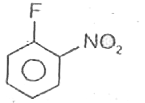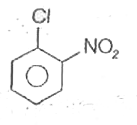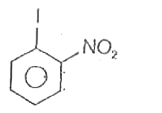Which of the following is least reactive towards nucleophilic substitution?




The correct Answer is:D
To determine which of the given compounds is least reactive towards nucleophilic substitution, we need to analyze the reactivity of the halogens present in the compounds. The halogens in question are fluorine (F), chlorine (Cl), bromine (Br), and iodine (I).
1. Understanding Nucleophilic Substitution:
- Nucleophilic substitution reactions involve the replacement of a leaving group (in this case, a halogen) by a nucleophile (a species that donates an electron pair).
- The reactivity of the compound towards nucleophilic substitution is influenced by the stability of the leaving group.
2. Identifying the Leaving Groups:
- The halogens (F, Cl, Br, I) can act as leaving groups. The stability of the leaving group is crucial for the reaction to occur.
- A good leaving group is typically a weak base.
3. Comparing the Halogens:
- As we move down the group in the periodic table (from F to I), the size of the halogen increases, and its electronegativity decreases.
- The order of leaving group ability is: I⁻ > Br⁻ > Cl⁻ > F⁻. This means iodine is the best leaving group, while fluorine is the worst.
4. Analyzing the Compounds:
- The compounds in question contain the following halogens:
- Option 1: Fluorine (F)
- Option 2: Chlorine (Cl)
- Option 3: Bromine (Br)
- Option 4: Iodine (I)
- Based on the leaving group ability, fluorine (F) is the least stable leaving group due to its small size and high electronegativity, making it a poor leaving group.
5. Conclusion:
- Since fluorine is the least stable leaving group, the compound containing fluorine will be the least reactive towards nucleophilic substitution.
- Therefore, the answer is Option 1 (the compound with fluorine).
- Nucleophilic substitution reactions involve the replacement of a leaving group (in this case, a halogen) by a nucleophile (a species that donates an electron pair).
- The reactivity of the compound towards nucleophilic substitution is influenced by the stability of the leaving group.
- The halogens (F, Cl, Br, I) can act as leaving groups. The stability of the leaving group is crucial for the reaction to occur.
- A good leaving group is typically a weak base.
- As we move down the group in the periodic table (from F to I), the size of the halogen increases, and its electronegativity decreases.
- The order of leaving group ability is: I⁻ > Br⁻ > Cl⁻ > F⁻. This means iodine is the best leaving group, while fluorine is the worst.
- The compounds in question contain the following halogens:
- Option 1: Fluorine (F)
- Option 2: Chlorine (Cl)
- Option 3: Bromine (Br)
- Option 4: Iodine (I)
- Based on the leaving group ability, fluorine (F) is the least stable leaving group due to its small size and high electronegativity, making it a poor leaving group.
- Since fluorine is the least stable leaving group, the compound containing fluorine will be the least reactive towards nucleophilic substitution.
- Therefore, the answer is Option 1 (the compound with fluorine).
Topper's Solved these Questions
- HALOALKANES AND HALOARENES BOOK - AAKASH INSTITUTE ENGLISHCHAPTER - HALOALKANES AND HALOARENES EXERCISE - ASSIGNMENT SECTION - C
39 Videos
- HALOALKANES AND HALOARENES BOOK - AAKASH INSTITUTE ENGLISHCHAPTER - HALOALKANES AND HALOARENES EXERCISE - ASSIGNMENT SECTION -D
15 Videos
- HALOALKANES AND HALOARENES BOOK - AAKASH INSTITUTE ENGLISHCHAPTER - HALOALKANES AND HALOARENES EXERCISE - ASSIGNMENT SECTON - A
45 Videos
- GENERAL PRINCIPLES AND PROCESSES OF ISOLATION OF ELEMENTSBOOK - AAKASH INSTITUTE ENGLISHCHAPTER - GENERAL PRINCIPLES AND PROCESSES OF ISOLATION OF ELEMENTSEXERCISE - Try Yourself
33 Videos
- HYDROCARBONSBOOK - AAKASH INSTITUTE ENGLISHCHAPTER - HYDROCARBONSEXERCISE - Assignment(Section - C) (Previous Years Questions)
60 Videos
Similar Questions
Knowledge Check
Which of the following is the most reactive towards nucleophilic substitution reaction?
AClCH2−CH=CH2BCH2=CH−ClCCH3CH=CH−ClDC6H5ClWhich ofthe following is most reactive towards nucleophilic substitution reaction ?
ACH2=CH−ClBC6H5ClCCH3CH=CHClDClCH2−CH=CH2Which one of the following is most reactive towards nucleophilic substitution reaction ?
ACH2=CH−ClBC6H5ClCCH3CH=CHClDClCH2−CH=CH2
Which of the following is least reactive in a nucleophilic substitution reaction?
View SolutionWhich of the following is least reactive in a nucleophilic substiution reaction
View SolutionWhich of the following is the most reactive towards electrophilic substitution?
View SolutionWhich of the following is least reactive towards SN1?
View SolutionWhich is least reactive towards nucleophilic substitution (SN2)
View Solution
